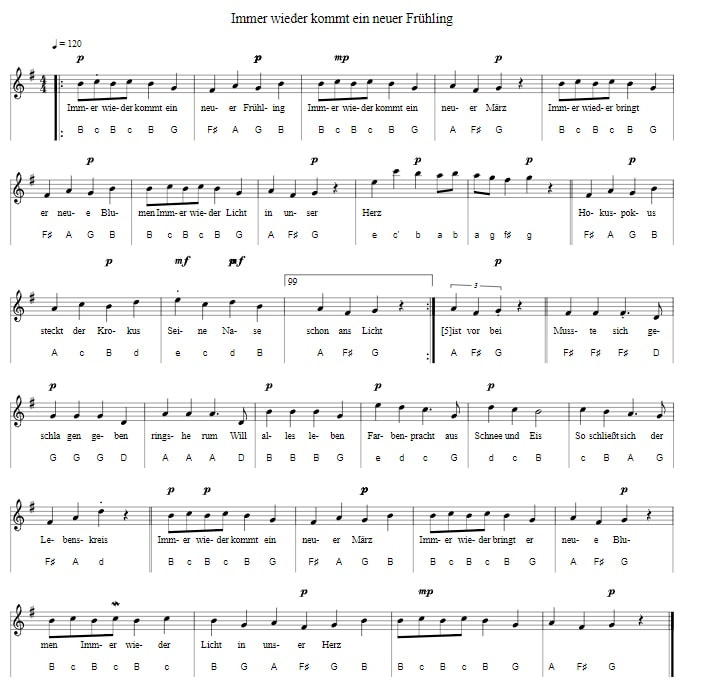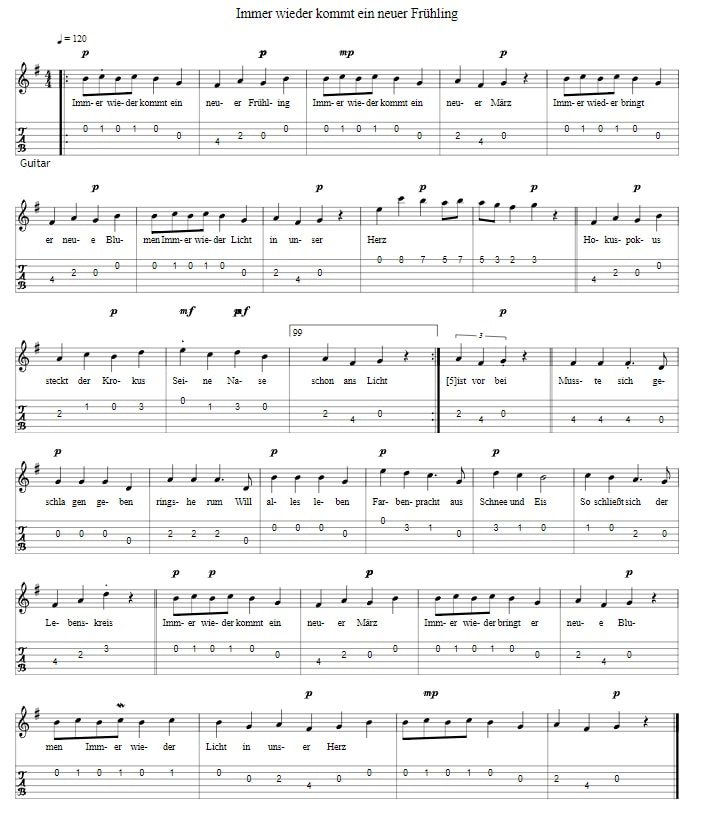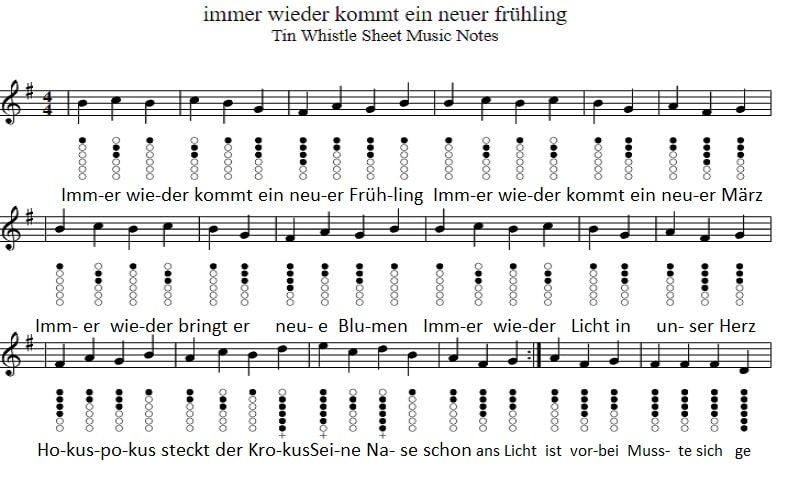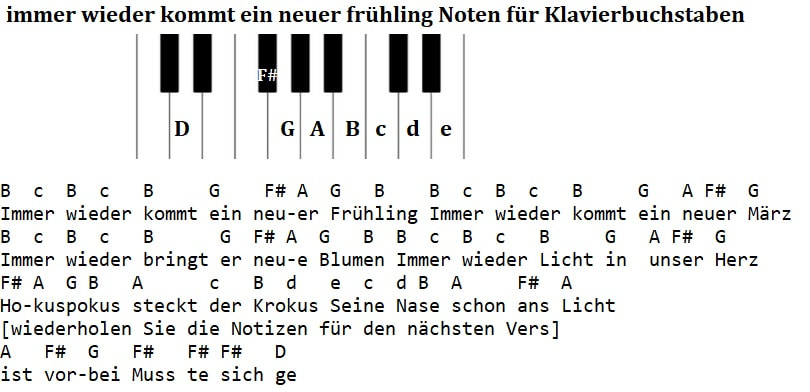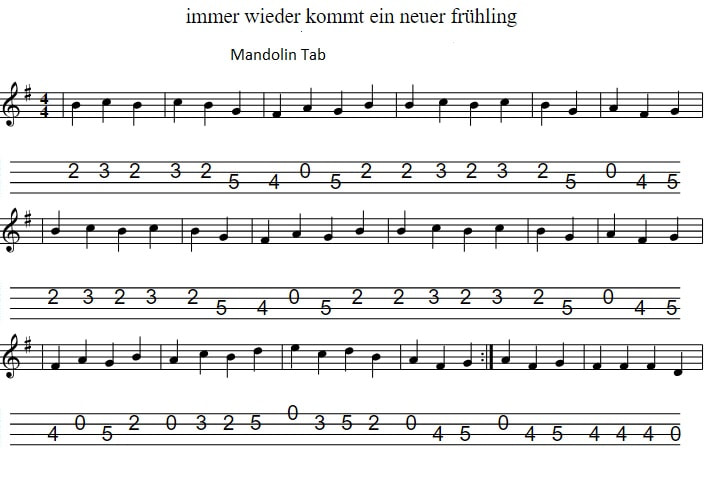Immer wieder kommt ein neuer Frühling lyrics and guitar chords
The tin whistle and mandolin sheet music notes are included. Return to the list of German folk songs .immer wieder kommt ein-neuer frühling Noten für Klavierbuchstaben
für Anfänger Anfänger
für Anfänger Anfänger
für Anfänger Anfänger
für Anfänger Anfänger
Rolf Zuckowski. Chords by Angela. Key of G
(G) Immer wieder kommt ein (D) neuer (G) Frühling
Immer wieder kommt ein (D) neuer (G) März. -
Immer wieder bringt er (D) neue (G) Blumen,
immer wieder Licht in (D) unser (G) Herz. – (C / G – D / - G)
(D) Hokus-(G)-pokus (D7) steckt der (G) Krokus
(C) seine (G) Nase (D) schon ans (G) Licht. – Immer wieder…
(D) Auch das (G) Häschen (D7) steckt sein (G) Näschen
(C) frech he-(G)-raus aus (D) seinem (G) Bau. – Immer wieder…
(D) Still und (G) leise (D7) hat die (G) Meise
(C) sich ein (G) neues (D) Nest ge-(G)-baut. – (G II – D – E7)
(A) Immer wieder kommt ein (E) neuer (A) Frühling
Immer wieder kommt ein (E) neuer (A) März. -
Immer wieder bringt er (E) neue (A) Blumen,
immer wieder Licht in (E) unser (A) Herz. – (D / A – E7 / A)
(E) Auch die (A) Schlange (E7) freut sich (A) lange
(D) schon auf (A) Ihre (E) neue (A) Haut. – Immer wieder…
(E) Und die (A) Sonne (E7) strahlt voll (A) Wonne
(D) denn der (A) Winter (E) ist vor-(A)-bei.
„(E) Musste sich ge-(A)-schlagen geben
(E) ringsherum will (A) alles leben
(D) Farbenpracht aus (A) Schnee und Eis,
(h) so schließt sich der (E) Le-(H7)-bens-(E)-kreis.
(C) Immer wieder kommt ein (G) neuer (C) Frühling
Immer wieder kommt ein (G) neuer (C) März. -
Immer wieder bringt er (G) neue (C) Blumen,
immer wieder Licht in (G) unser (C) Herz – (F / C – G7 / C)
(C) Immer wieder kommt ein (G) neuer (C) Frühling
Immer wieder kommt ein (G) neuer (C) März.
(G) Immer wieder kommt ein (D) neuer (G) Frühling
Immer wieder kommt ein (D) neuer (G) März. -
Immer wieder bringt er (D) neue (G) Blumen,
immer wieder Licht in (D) unser (G) Herz. – (C / G – D / - G)
(D) Hokus-(G)-pokus (D7) steckt der (G) Krokus
(C) seine (G) Nase (D) schon ans (G) Licht. – Immer wieder…
(D) Auch das (G) Häschen (D7) steckt sein (G) Näschen
(C) frech he-(G)-raus aus (D) seinem (G) Bau. – Immer wieder…
(D) Still und (G) leise (D7) hat die (G) Meise
(C) sich ein (G) neues (D) Nest ge-(G)-baut. – (G II – D – E7)
(A) Immer wieder kommt ein (E) neuer (A) Frühling
Immer wieder kommt ein (E) neuer (A) März. -
Immer wieder bringt er (E) neue (A) Blumen,
immer wieder Licht in (E) unser (A) Herz. – (D / A – E7 / A)
(E) Auch die (A) Schlange (E7) freut sich (A) lange
(D) schon auf (A) Ihre (E) neue (A) Haut. – Immer wieder…
(E) Und die (A) Sonne (E7) strahlt voll (A) Wonne
(D) denn der (A) Winter (E) ist vor-(A)-bei.
„(E) Musste sich ge-(A)-schlagen geben
(E) ringsherum will (A) alles leben
(D) Farbenpracht aus (A) Schnee und Eis,
(h) so schließt sich der (E) Le-(H7)-bens-(E)-kreis.
(C) Immer wieder kommt ein (G) neuer (C) Frühling
Immer wieder kommt ein (G) neuer (C) März. -
Immer wieder bringt er (G) neue (C) Blumen,
immer wieder Licht in (G) unser (C) Herz – (F / C – G7 / C)
(C) Immer wieder kommt ein (G) neuer (C) Frühling
Immer wieder kommt ein (G) neuer (C) März.
Chords in the key of C
(C) Immer wieder kommt ein (G) neuer (C) Frühling
Immer wieder kommt ein (G) neuer (C) März. -
Immer wieder bringt er (G) neue (C) Blumen,
immer wieder Licht in (G) unser (C) Herz.
(G) Hokus-(C)-pokus (G7) steckt der (C) Krokus
(F) seine (C) Nase (G) schon ans (C) Licht. – Immer wieder…
(G) Auch das (C) Häschen (G7) steckt sein (C) Näschen
(F) frech he-(C)-raus aus (G) seinem (C) Bau. – Immer wieder…
(G) Still und (C) leise (G7) hat die (C) Meise
(F) sich ein (C) neues (G) Nest ge-(C)-baut. –
(D) Immer wieder kommt ein (A) neuer (D) Frühling
Immer wieder kommt ein (A) neuer (D) März. -
Immer wieder bringt er (A) neue (D) Blumen,
immer wieder Licht in (A) unser (D) Herz. –
(A) Auch die (D) Schlange (A7) freut sich (D) lange
(G) schon auf (D) Ihre (A) neue (D) Haut. – Immer wieder…
(A) Und die (D) Sonne (A7) strahlt voll (D) Wonne
(G) denn der (D) Winter (A) ist vor-(D)-bei.
„(A) Musste sich ge-(D)-schlagen geben
(A) ringsherum will (D) alles leben
(G) Farbenpracht aus (D) Schnee und Eis,
(h) so schließt sich der (A) Le-(H7)-bens-(A)-kreis.
(F) Immer wieder kommt ein (C) neuer (F) Frühling
Immer wieder kommt ein (C) neuer (F) März. -
Immer wieder bringt er (C) neue (F) Blumen,
immer wieder Licht in (C) unser (F) Herz –
(F) Immer wieder kommt ein (C) neuer (F) Frühling
Immer wieder kommt ein (C) neuer (F) März.
(C) Immer wieder kommt ein (G) neuer (C) Frühling
Immer wieder kommt ein (G) neuer (C) März. -
Immer wieder bringt er (G) neue (C) Blumen,
immer wieder Licht in (G) unser (C) Herz.
(G) Hokus-(C)-pokus (G7) steckt der (C) Krokus
(F) seine (C) Nase (G) schon ans (C) Licht. – Immer wieder…
(G) Auch das (C) Häschen (G7) steckt sein (C) Näschen
(F) frech he-(C)-raus aus (G) seinem (C) Bau. – Immer wieder…
(G) Still und (C) leise (G7) hat die (C) Meise
(F) sich ein (C) neues (G) Nest ge-(C)-baut. –
(D) Immer wieder kommt ein (A) neuer (D) Frühling
Immer wieder kommt ein (A) neuer (D) März. -
Immer wieder bringt er (A) neue (D) Blumen,
immer wieder Licht in (A) unser (D) Herz. –
(A) Auch die (D) Schlange (A7) freut sich (D) lange
(G) schon auf (D) Ihre (A) neue (D) Haut. – Immer wieder…
(A) Und die (D) Sonne (A7) strahlt voll (D) Wonne
(G) denn der (D) Winter (A) ist vor-(D)-bei.
„(A) Musste sich ge-(D)-schlagen geben
(A) ringsherum will (D) alles leben
(G) Farbenpracht aus (D) Schnee und Eis,
(h) so schließt sich der (A) Le-(H7)-bens-(A)-kreis.
(F) Immer wieder kommt ein (C) neuer (F) Frühling
Immer wieder kommt ein (C) neuer (F) März. -
Immer wieder bringt er (C) neue (F) Blumen,
immer wieder Licht in (C) unser (F) Herz –
(F) Immer wieder kommt ein (C) neuer (F) Frühling
Immer wieder kommt ein (C) neuer (F) März.
Immer wieder kommt ein neuer Frühling sheet music with letter notes
Chords in the key of D
(D) Immer wieder kommt ein (A) neuer (D) Frühling
Immer wieder kommt ein (A) neuer (D) März. -
Immer wieder bringt er (A) neue (D) Blumen,
immer wieder Licht in (A) unser (D) Herz.
(A) Hokus-(D)-pokus (A7) steckt der (D) Krokus
(G) seine (D) Nase (A) schon ans (D) Licht. – Immer wieder…
(A) Auch das (D) Häschen (A7) steckt sein (D) Näschen
(G) frech he-(D)-raus aus (A) seinem (D) Bau. – Immer wieder…
(A) Still und (D) leise (A7) hat die (D) Meise
(G) sich ein (D) neues (A) Nest ge-(D)-baut. –
(E) Immer wieder kommt ein (B) neuer (E) Frühling
Immer wieder kommt ein (B) neuer (E) März. -
Immer wieder bringt er (B) neue (E) Blumen,
immer wieder Licht in (B) unser (E) Herz. –
(B) Auch die (E) Schlange (B7) freut sich (E) lange
(A) schon auf (E) Ihre (B) neue (E) Haut. – Immer wieder…
(B) Und die (E) Sonne (B7) strahlt voll (E) Wonne
(A) denn der (E) Winter (B) ist vor-(E)-bei.
„(B) Musste sich ge-(E)-schlagen geben
(B) ringsherum will (E) alles leben
(A) Farbenpracht aus (E) Schnee und Eis,
(h) so schließt sich der (B) Le-(H7)-bens-(B)-kreis.
(G) Immer wieder kommt ein (D) neuer (G) Frühling
Immer wieder kommt ein (D) neuer (G) März. -
Immer wieder bringt er (D) neue (G) Blumen,
immer wieder Licht in (D) unser (G) Herz –
(G) Immer wieder kommt ein (D) neuer (G) Frühling
Immer wieder kommt ein (D) neuer (G) März.
Chords in the key of D
(D) Immer wieder kommt ein (A) neuer (D) Frühling
Immer wieder kommt ein (A) neuer (D) März. -
Immer wieder bringt er (A) neue (D) Blumen,
immer wieder Licht in (A) unser (D) Herz.
(A) Hokus-(D)-pokus (A7) steckt der (D) Krokus
(G) seine (D) Nase (A) schon ans (D) Licht. – Immer wieder…
(A) Auch das (D) Häschen (A7) steckt sein (D) Näschen
(G) frech he-(D)-raus aus (A) seinem (D) Bau. – Immer wieder…
(A) Still und (D) leise (A7) hat die (D) Meise
(G) sich ein (D) neues (A) Nest ge-(D)-baut. –
(E) Immer wieder kommt ein (B) neuer (E) Frühling
Immer wieder kommt ein (B) neuer (E) März. -
Immer wieder bringt er (B) neue (E) Blumen,
immer wieder Licht in (B) unser (E) Herz. –
(B) Auch die (E) Schlange (B7) freut sich (E) lange
(A) schon auf (E) Ihre (B) neue (E) Haut. – Immer wieder…
(B) Und die (E) Sonne (B7) strahlt voll (E) Wonne
(A) denn der (E) Winter (B) ist vor-(E)-bei.
„(B) Musste sich ge-(E)-schlagen geben
(B) ringsherum will (E) alles leben
(A) Farbenpracht aus (E) Schnee und Eis,
(h) so schließt sich der (B) Le-(H7)-bens-(B)-kreis.
(G) Immer wieder kommt ein (D) neuer (G) Frühling
Immer wieder kommt ein (D) neuer (G) März. -
Immer wieder bringt er (D) neue (G) Blumen,
immer wieder Licht in (D) unser (G) Herz –
(G) Immer wieder kommt ein (D) neuer (G) Frühling
Immer wieder kommt ein (D) neuer (G) März.
Immer wieder kommt ein neuer Frühling guitar tab
The song 'Immer wieder kommt ein neuer Frühling' has become a beloved classic in German music, with its timeless message of hope, renewal, and the cyclical nature of life. Originally written and composed by the Austrian musician and poet, Hermann Leopoldi, in the early 20th century, the song has since been covered by numerous artists and has been passed down through generations, remaining relevant and resonating with audiences to this day.
The title of the song, which translates to 'A New Spring Always Comes Again,' immediately captures the attention of the listener with its optimistic and comforting message. The idea of a new beginning, a fresh start, and the promise of better days ahead is a universal concept that appeals to people of all ages and backgrounds. This is perhaps why the song has stood the test of time and continues to be popular even after more than a hundred years since its creation.
One of the reasons for the enduring popularity of 'Immer wieder kommt ein neuer Frühling' is its uplifting and inspiring lyrics. The song is a celebration of nature, with its references to the blooming of flowers, the singing of birds, and the return of warmth and sunshine after the cold and dark winter. This imagery not only creates a vivid picture in the listener's mind but also serves as a metaphor for the cyclical nature of life. Just as nature goes through its cycles of growth and renewal, so do our lives. This message of hope and perseverance in the face of adversity is a timeless one that resonates with people of all ages.
Furthermore, the song's melody is simple yet beautiful, making it easy to remember and sing along to. This, coupled with the song's powerful message, has made it a popular choice for choirs and amateur singers alike. It has been performed at countless events, from school concerts to community gatherings, and has become a staple in German folk music.
Another factor contributing to the song's enduring popularity is its ability to adapt to changing times and contexts. Over the years, 'Immer wieder kommt ein neuer Frühling' has been covered by various artists, each adding their own unique touch to the song. From sentimental ballads to upbeat pop versions, the song has been reimagined in different genres, making it accessible to a wider audience. This has ensured its relevance and popularity in contemporary music, cementing its status as a timeless classic.
Moreover, the song's message of hope and resilience has taken on an even deeper meaning during times of crisis. During World War II, the song was banned by the Nazi regime for its anti-war message, but it continued to be sung in secret by those who found solace in its words. Similarly, during the COVID-19 pandemic, the song was once again embraced by the public as a source of comfort and hope during uncertain times. This further highlights the song's ability to transcend time and resonate with people in different contexts.
In conclusion, 'Immer wieder kommt ein neuer Frühling' is more than just a song; it is a cultural phenomenon that has stood the test of time. Its timeless message of hope, renewal, and the cyclical nature of life has made it a beloved classic in German music. Through its uplifting lyrics, beautiful melody, and ability to adapt to changing times, the song has captured the hearts of generations and will continue to do so for years to come.
The title of the song, which translates to 'A New Spring Always Comes Again,' immediately captures the attention of the listener with its optimistic and comforting message. The idea of a new beginning, a fresh start, and the promise of better days ahead is a universal concept that appeals to people of all ages and backgrounds. This is perhaps why the song has stood the test of time and continues to be popular even after more than a hundred years since its creation.
One of the reasons for the enduring popularity of 'Immer wieder kommt ein neuer Frühling' is its uplifting and inspiring lyrics. The song is a celebration of nature, with its references to the blooming of flowers, the singing of birds, and the return of warmth and sunshine after the cold and dark winter. This imagery not only creates a vivid picture in the listener's mind but also serves as a metaphor for the cyclical nature of life. Just as nature goes through its cycles of growth and renewal, so do our lives. This message of hope and perseverance in the face of adversity is a timeless one that resonates with people of all ages.
Furthermore, the song's melody is simple yet beautiful, making it easy to remember and sing along to. This, coupled with the song's powerful message, has made it a popular choice for choirs and amateur singers alike. It has been performed at countless events, from school concerts to community gatherings, and has become a staple in German folk music.
Another factor contributing to the song's enduring popularity is its ability to adapt to changing times and contexts. Over the years, 'Immer wieder kommt ein neuer Frühling' has been covered by various artists, each adding their own unique touch to the song. From sentimental ballads to upbeat pop versions, the song has been reimagined in different genres, making it accessible to a wider audience. This has ensured its relevance and popularity in contemporary music, cementing its status as a timeless classic.
Moreover, the song's message of hope and resilience has taken on an even deeper meaning during times of crisis. During World War II, the song was banned by the Nazi regime for its anti-war message, but it continued to be sung in secret by those who found solace in its words. Similarly, during the COVID-19 pandemic, the song was once again embraced by the public as a source of comfort and hope during uncertain times. This further highlights the song's ability to transcend time and resonate with people in different contexts.
In conclusion, 'Immer wieder kommt ein neuer Frühling' is more than just a song; it is a cultural phenomenon that has stood the test of time. Its timeless message of hope, renewal, and the cyclical nature of life has made it a beloved classic in German music. Through its uplifting lyrics, beautiful melody, and ability to adapt to changing times, the song has captured the hearts of generations and will continue to do so for years to come.
immer wieder kommt ein neuer frühling tin whistle sheet music notes
Immer wieder kommt ein neuer frühling mandolin tab
